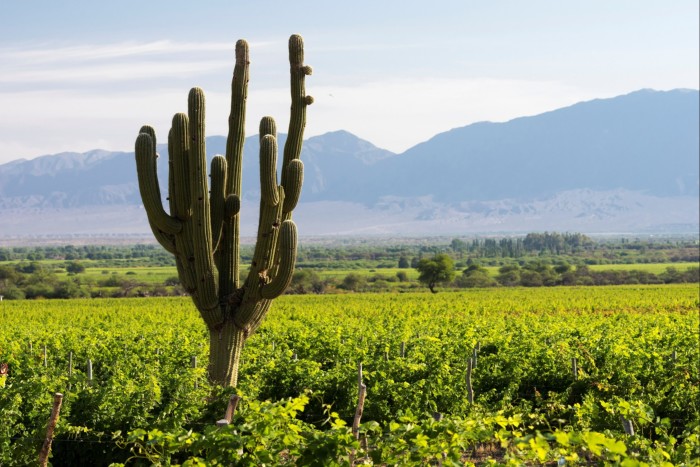
Popping ears is not a sensation you would associate with visiting a vineyard. Nor is the sight of giant cactii standing amid the vines. But Salta, one of Argentina’s buzziest new wine frontiers, in the mountainous north-west, thrives on unconventional viticulture.
Grapes are grown at improbably high altitudes — more than 3,000 metres — and in semi-desert valleys. Your glass of Malbec might pair a local delicacy such as carpaccio of llama (deliciously soft, lean and light) or home-made carob ice cream. And a stroll through the vineyards could take you past giant stones with round holes gouged in them where, centuries ago, the Inca people squatted to grind corn.
Although it is one of Argentina’s newest fine wine areas, the industry’s history in Salta goes back two centuries. Some estates claim vines dating from the early 1830s — not that long after the region gained independence from Spanish imperial rule. That makes them about as old as some of the local cardón cacti, which can grow as high as 8m, dwarfing the vines around them.

Until the 1990s, Salta lived in the shadow of Argentina’s dominant wine region of Mendoza, producing modest quantities of wine from the aromatic national white grape, Torrontés, mainly for local consumption.
“In Buenos Aires, they might drink a coffee at 11 in the morning but, in Salta, we prefer to eat a couple of beef empanadas with a glass of Torrontés,” notes local resident Raúl Goytia, who has lived in the province all his life.
Even today, Salta’s wine production is tiny, just 212,000 hectolitres, representing about 2.4 per cent of the national total. But the area under vines has expanded by 25 per cent in the past decade, making it one of the fastest-growing wine areas in the country.
A new generation of owners has arrived, including foreign investors with deep pockets and big ambitions. Minnesota businessman Jon Malinski and his wife Arlene founded the Piattelli estate outside the wine region’s main town of Cafayate, planting 300 hectares of vines and building a wine resort for couples run along Californian lines — under the banner “relax, reflect and reconnect”.
Older vineyards were greatly expanded with European grape varieties, such as Cabernet Sauvignon, and new ones created, some under expert advice from overseas. Michel Rolland, the Pomerol guru known as the “flying winemaker” for his extensive international advice, swooped in to help the Etchart family develop their Yacochuya wine into an international brand.
“Salta wines stand out for their unique terroir,” says Magdalena Pesce, chief executive of national marketing champion Wines of Argentina, noting that the extreme altitude “gives the wines balanced acidity, more intense aromas and more concentrated flavours”.
Swiss entrepreneur and philanthropist Donald Hess, who died last year, helped pioneer luxury wine tourism in Salta at his Colomé estate. Located in a remote mountain valley reached along bone-shaking dirt roads, Colomé boasts an hacienda-style hotel, a museum dedicated to the Californian “master of light”, installation artist James Turrell, and a restaurant featuring original creations from local ingredients. Patricia Courtois, gastronomic adviser, flags llama liver as one of her discoveries. “The colour is dark, almost black, but it’s absolutely delicious and very like foie gras,” she says.
Hess also pursued an ambition to own the highest-altitude vineyard in the Americas, planting Malbec, Pinot Noir and Sauvignon Blanc grapes at 3,111m to produce Colomé’s Altura Máxima wines which sell for up to $150 a bottle retail. Guinness World Records says the highest vineyard of all is in Tibet at 3,563m.
Jancis Robinson, the FT’s wine correspondent, declares herself a “big fan” of high-altitude wines, in general. “There does seem to be an extra directness about the fruit — perhaps because of the cooler nights and the quality of ultra violet light,” she says.
Today, from the Andean foothills outside Cafayate, vineyards stretch away in all directions. The town has embraced wine in a big way — a large shop sign in the centre touts itself as “the creator of wine ice cream” and there is a vine and wine museum.
It is still remote, lying four hours by road along a spectacular mountain valley from the nearest commercial airport in Salta, but an airstrip currently used by private jets hints at future ambition.
At El Esteco, a traditional winery and estate outside Cafayate originally built at the end of the 19th century, Argentina’s wealthy Bemberg family — who first made their fortune in beer — have invested to expand and improve production. “The Cafayate valley has fantastic growth potential,” says Alejandro Pepa, Esteco’s oenologist, highlighting the estate’s Cabernet Sauvignon wines as some of the best expressions of the terroir.
Despite improving quality dramatically and diversifying grape varieties, the region still has a way to go with its international image. “In the US, you have to explain where Salta is,” admits oenologist Jorge Noguera. “You also have to explain why it’s not Mendoza, and why it is not just Torrontés grapes.”
Like their much better known counterparts in Mendoza, Salta’s winemakers face challenges peculiar to their country. Credit is impossibly expensive and no foreign lender will touch Argentina because of its capital controls, so owners must fund investment entirely from profits or savings.
“If we were in Europe or the United States, we would have a Ferrari parked outside the vineyard,” rues winemaker Arnaldo Etchart at Bodega Yacochuya. “Not a Volkswagen Amarok [pick-up truck].”